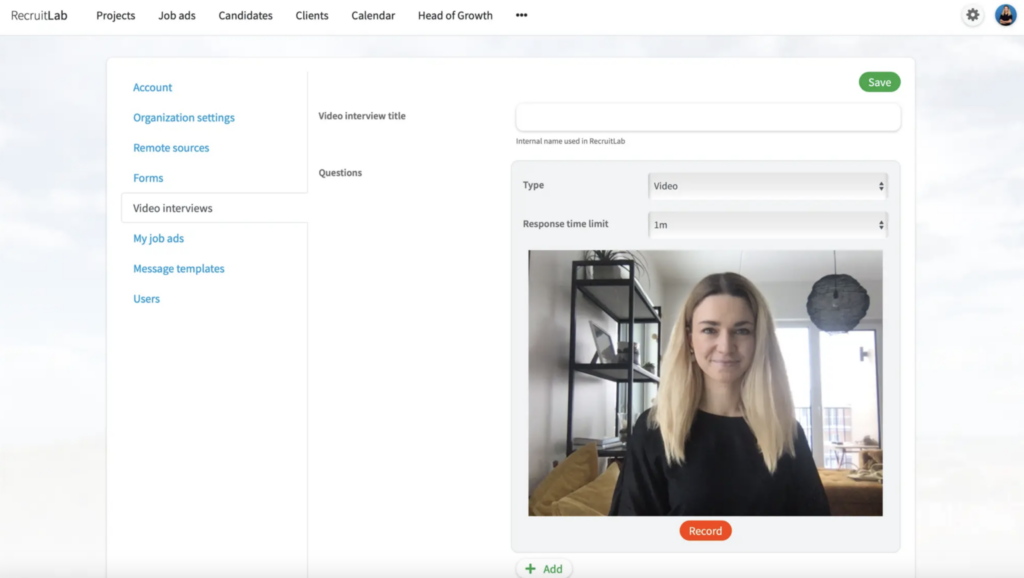Recruiters and hiring managers are always looking for ways to be more effective in hiring top talent and reducing time-to-hire. The world of recruitment has evolved rapidly in recent years, with video recruitment becoming an increasingly important part of the process. The COVID-19 pandemic forced companies to adapt quickly to the new reality. Video recruitment is widely used for hiring remotely from the global workforce and for many companies, it has become part of the day-to-day recruitment strategy.
This comprehensive guide will explore the different aspects of video recruitment, its benefits to both recruiters and candidates, and why it may not necessarily replace in-person interviews. We’ll also delve into effective video recruitment strategies to help you make the most of this technology.

What is Video Recruitment?
Video recruitment encompasses a range of options for leveraging video technology in the hiring process. These options include video interviews, asynchronous video interviews, and recruitment videos. Video interviewing offers several advantages over traditional in-person interviews, making it an attractive option for many companies. Initially, video recruitment was something only the first adopters were utilising, but it has now become the norm due to the numerous benefits.
Nearly 75% of companies are currently using real-time video platforms to interview leading candidates.
50 percent use video interviews as a way to narrow the candidate pool, survey results revealed. (SHRM.org)
What are Video Interviews?
Live video interviews are real-time, face-to-face conversations between a candidate and a recruiter conducted via video conferencing platforms such as Zoom, Microsoft Teams, or Google Meet.
These interviews can replace the traditional phone or in-person interviews, enabling recruiters to connect with candidates remotely. Using an ATS helps recruiters schedule and conduct these interviews and eliminates scheduling and time zone conflicts. It also eliminates the need to toggle between multiple applications.
Video interviews can be an effective tool for screening candidates during the initial stages of the hiring process. Recruiters can review video interviews more quickly than conducting in-person interviews, allowing them to move through the candidate pool more efficiently.
What are Asynchronous Video Interviews?
Asynchronous video interviews, also known as one-way video interviews or pre-recorded interviews, allow candidates to record video responses to a set of pre-determined questions.
Recruiters can then review these responses at their convenience. It speeds up the recruitment process and allows for interviewing more candidates in the same amount of time. Instead of having a live (video) interview or calling each candidate separately, the recruiter can send out the pre-recorded video questions to as many candidates as they wish. Asynchronous video interviews eliminate scheduling conflicts and provide a standardised way of assessing candidates. Each candidate is presented with the questions in the same manner.
Teamdash’s statistics show that asynchronous video interviews with video questions have a 96% response rate compared to a 90% with text questions.

What is a Recruitment Video?
A recruitment video is a promotional tool used by companies to showcase their workplace culture, values, and employee experiences. While it doesn’t directly involve candidate assessment, it plays a crucial role in attracting the right talent to your organisation.
You can also add a video greeting or explainer to your recruitment email to increase your email click-through rate and effortlessly make your offer stand out and more personal. Recruitment videos are also a way to introduce the potential hire to the team remotely.
Teamdash’s clients have seen a 300% lift in their email click-through rate thanks to the video email feature.
The Benefits of Video Recruitment
Video recruitment offers significant advantages for both recruiters and candidates. Let’s list and explain the most important ones for both:
Video Recruitment Benefits for Recruiters
Cost and time savings
Video interviews can save time and money by reducing the need for in-person interviews, especially for remote or international candidates. Video interviews reduce the need for travel or commute, saving both candidates and companies time and money. This is especially beneficial when considering candidates from different geographical locations or countries.
KPMG, a multinational professional services network, said that instead of holding 30-minute meetings with 40 people, they watched 40 2-minute recorded video responses.
That’s 1200 minutes spent on interviews vs 80 minutes spent on watching responses!
Read more about how they save time and money in a case study.
Wider talent pool
By eliminating geographical barriers, video recruitment enables organizations to reach a broader, more diverse pool of candidates. This can lead to better quality hires, as recruiters are not limited to the local talent market.
Standardised assessment
Asynchronous video interviews help recruiters assess candidates more consistently, reducing the risk of bias. The candidates receive the same questions and the same amount of time to respond. The evaluation is not affected by the recruiter’s stress level or tight schedule that day.
Teamdash’s ATS offers the function of prerecording your video questions and storing them as templates for other recruiting projects or stages as well.
Therefore, you save time by not having the need to start from scratch with each project.
Enhanced candidate experience
Video recruitment can be more efficient and less stressful for candidates, leaving a positive impression of your company. Candidates can participate from the comfort of their own homes or a familiar environment. It also eliminates the time spent commuting to the physical meet-up space which frees up more time in the calendar for all parties.
You can also add video messages to your emails to make them feel more personalised and also give feedback this way.
Video Recruitment Benefits for Candidates
Flexibility
Candidates can participate in video interviews from the comfort of their homes, reducing travel expenses and time. They can also choose a time outside the regular working hours to submit their responses.
Better preparation
Asynchronous video interviews give candidates more time to prepare and reflect on their answers, showcasing their best qualities. As the hiring project owner you can also set the time limits and number of attempts the candidate has in submitting the video responses and the candidates can plan accordingly.
Access to opportunities
Video recruitment allows candidates to explore job opportunities beyond their local area, increasing their chances of finding the right fit. They only need a computer with a webcam and a microphone and a good Internet connection.
Do Video Interviews Replace In-Person Interviews?
While video interviews have become an essential tool in the recruitment process, they do not necessarily replace in-person interviews for all positions. For remote roles or specific jobs where the primary mode of communication is online, video interviews might be sufficient. However, for other roles, video interviews serve as a valuable screening tool to supplement the traditional in-person interview process.
One of video interviews’ biggest benefits over traditional in-person interviews is the fact that video interviews can be recorded and shared among hiring team members for collective evaluation and feedback. This can lead to better decision-making and help to ensure the chosen candidate is the right fit for the company. Of course, the candidate needs to be informed when they are being recorded.

Video Recruitment Strategies
Choose the right platform
Select a reliable video conferencing platform that offers a secure, user-friendly experience for both recruiters and candidates. Always prefer a video platform that doesn’t require installing additional software on the candidate side. Using an ATS eliminates the need to toggle between multiple applications and keeps everything on one platform.
Prepare structured interview questions
Develop a set of well-thought-out questions that assess the candidate’s skills, experience, and fit for the role. This helps stay within the time limitations and gets you the relevant information about the candidate. It makes it easier for you to compare the responses of different candidates.
Provide clear instructions
Ensure candidates understand the technical requirements and process of the video interview, including how to access the platform (e.g. include passwords or inform them about a virtual waiting room, if there is one) and how to submit their responses. Inform the candidates about the time limitations and the number of attempts they have.
Establish a professional environment
Conduct video interviews in a quiet, well-lit space free from distractions and with a good Internet connection to avoid technical issues during the interview. Maintain the same level of professionalism as you would during an in-person interview. If you are interviewing candidates from a home office, let other family members know that you are interviewing. You want the candidate to leave the video interview with a good impression of the company.
Train your recruitment team
Ensure your recruiters are proficient in using the chosen video platform. When you lead a team of recruiters, you can provide them with a uniform guide on how to conduct these interviews. Adopting a new software can be daunting so provide everyone with sufficient resources to make them comfortable with recruiting via video.
Video Recruitment Summary
Video recruitment has become an essential tool in the modern hiring process, offering a range of options including video interviews, asynchronous video interviews, and recruitment videos.
The benefits of video recruitment extend to both recruiters and candidates, providing cost and time savings, increased flexibility, access to a wider talent pool, and reduced interviewer bias. While video interviews may not completely replace in-person interviews for all roles, they serve as an effective screening and evaluation tool in many cases.
As organisations continue to adapt to the evolving recruitment landscape, embracing video recruitment and implementing effective strategies will be key to attracting and retaining top talent.
Teamdash – The all-in-one recruitment software.
Streamline your recruitment process, save up to 70% of your time and hire top talent fast.


